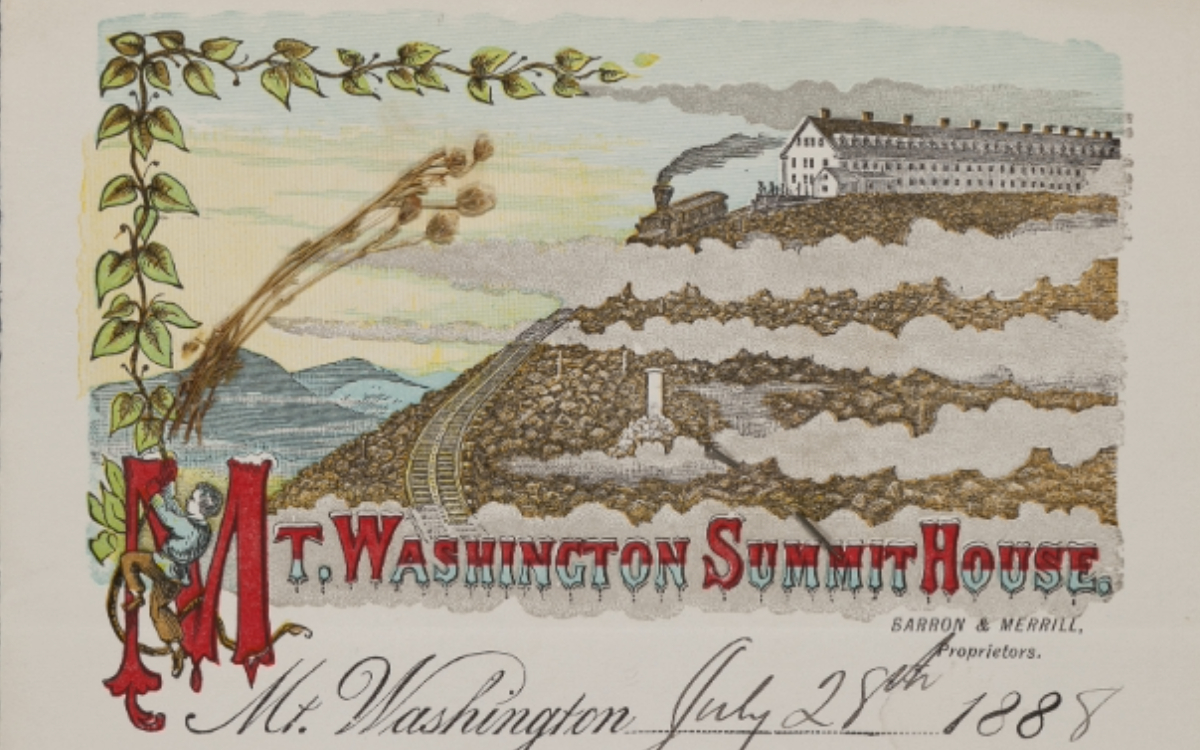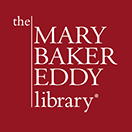From the Papers: “This is my message in love”

Josephine Curtis Woodbury and Janette E. Weller to Mary Baker Eddy, July 28, 1888, 338AP1.46.029.
In the work of publishing Mary Baker Eddy’s correspondence, sermons, and other manuscripts, The Mary Baker Eddy Papers team recently encountered a letter. It immediately stood out for several reasons: the colorful, illustrated letterhead, the unusual location from which it was sent, and the fact that some wildflowers—affixed to it in 1888—are still with the document! You can see them in the letter’s digital scan.
Our team wondered about the story behind this unique letter. What could it contribute to our understanding of the Christian Science movement at the time it was written? Here is what we discovered.
In late July 1888, two of Mary Baker Eddy’s students, Josephine Curtis Woodbury and Janette E. Weller, traveled together to the summit of Mount Washington. Located in the Presidential Range of New Hampshire’s White Mountains, it reaches 6,288 feet above sea level—one of the highest and most rugged peaks in the United States east of the Rocky Mountains. It is also famous for its extreme weather, as the snow- and ice-covered words in the letterhead allude to. According to the United States Forest Service, it is “one of the most inhospitable places on the planet.” And the foreboding claims continue:
The first day of spring often brings temperatures well below freezing, if not well below zero. Mid-summer can bring driving rain, freak snowstorms, gale force winds, and a high temperature that rarely reaches 70 degrees. The first visitors to the Presidential Range in the White Mountains of New Hampshire called them “daunting terrible” and “a vast howling wilderness.”1
This likely explains why Woodbury and Weller visited in July, and that rather than climbing up—as the figure in the letterhead is doing—they probably got to the summit on the Mount Washington Cog Railway, also shown. Completed in 1869, it was the first cog railway built in the world, and at the time it was regarded as a near miracle of engineering and ingenuity.2
When Woodbury and Weller reached the summit, they would have disembarked at the Summit House depicted at the terminus of the railway. It was a three-story, 91-room hotel that also contained heated parlors, a restaurant, a post and telegraph office, and a gift counter.3 Here Woodbury and Weller likely obtained this souvenir stationery on which they wrote this letter to Eddy:
Mt. Washington July 28th 1888
My Beloved Teacher.
I have brought your writings on Divine Science to the highest habitable point in our country- and I love God for letting me do it. I leave them here to lead the people- up to God.
“Not from the cultured gardens,
And not from the daisied sod
Do we bring our little offering—
But down from the hills of of God”4
Your loving grateful student
Josephine C. Woodbury
My dear Teacher,
This is my message in love
Mrs J. E. Robinson5
What motivated Woodbury and Weller to take Eddy’s writings to the top of Mount Washington? The latter half of the 1880s (the time period encompassing the documents that the Papers team is currently processing) was defined by a rapidly growing interest in Christian Science. A major factor contributing to this was increased public access to a growing body of Christian Science literature. During this time Eddy continually revised and published new editions of Science and Health with Key to the Scriptures. She also wrote several shorter articles and pamphlets. Besides Science and Health, a number of her other writings were available at that time: Defence of Christian Science (1885), Christian Healing (1886), The People’s Idea of God: Its Effect on Health and Christianity (1886), Mind-Healing: Historical Sketch (1886), Christian Science: No and Yes (1887), Rudiments and Rules of Christian Science (1887), Unity of Good and Unreality of Evil (1887), and No and Yes (1887). These publications were advertised in The Christian Science Journal, and its subscribers could write to Boston to order them.
But in the late 1880s the real heavy lifting in disseminating Christian Science literature was being done by Eddy’s students. The Mary Baker Eddy Papers website features a map of places where letters to Eddy originated.6 It shows that between 1886 and 1889 there were definite “hot spots” of correspondence, radiating out from locations where Eddy’s most established and active students maintained teaching and healing practices. And many of these students regularly placed large orders of her writings, which they then distributed.7 Zooming in on the interactive map also shows incoming correspondence from individuals in places far from the epicenters of Christian Science activity. This can be partly attributed to the fact that Eddy’s students didn’t only disseminate close to home the literature they ordered. The letter from Woodbury and Weller provides a notable example of the lengths to which they sometimes went.
The summit of Mount Washington might at first seem an unfruitful place to generate interest in Christian Science. But according to information printed on the reverse of the Summit House stationery, more than 20,000 people visited there in 1887 alone—presumably from all over the United States and beyond.8 In addition to this, the letter implies that Woodbury and Weller believed that the types of people drawn to the extremities of the highest summit in the Northeast would also be receptive to being led “up to God.”
Not only did Woodbury and Weller want Eddy to know that they had distributed her writings at the summit of Mount Washington; they also sought to communicate their loving regard for her. And their little gift of wildflowers “down from the hills of God” conveyed this message. Along with the flowers attached to her side of the letter, Woodbury excerpted a stanza apropos of the occasion, from a poem written in honor of William Cullen Bryant, one of the most beloved poets of the time.9 For her part, Weller was content to let the flowers on her side of the letter speak for themselves. Beneath them she wrote simply, “This is my message in love.”
According to the United States Forest Service, Mount Washington was, then as now, famous for its wildflowers:
Fascinating and beautiful plants can be observed all over the mountain, but it is the alpine species which seem to capture our imagination. Stranded in their high altitude homes as the last glacier receded, many of these species are also found on the tundra hundreds of miles to the north. A visit to Mount Washington in early summer is well rewarded. Wonderful arrays of blooms stand out in sharp contrast to its green forests and the gray broken rocks of the alpine zone.10
From the beginning, explorers of the mountain’s summit have marveled that anything at all can grow in such extreme conditions—much less the tiny, delicate-looking alpine flowers abundantly present there.
Eddy loved flowers.11 And a passage she wrote in Science and Health can easily call to mind those wildflowers billowing in the wind at the summit of Mount Washington: “Arctic regions, sunny tropics, giant hills, winged winds, mighty billows, verdant vales, festive flowers, and glorious heavens, — all point to Mind, the spiritual intelligence they reflect.”12 The alpine wildflowers in this letter must have captured her imagination as well. Rather than sending them out with the kitchen scraps after they had faded, she kept them with the letter, and they have endured along with it ever since.
It’s charming to imagine Woodbury and Weller exploring the summit of Mount Washington together in the beauty of late summer—exulting in its panoramic views, brisk weather, and abundant wildflowers, and fondly remembering Eddy. Likening that peak to “the hills of God,” they felt inspired to leave her writings there for discovery by a diverse public that Christian Science had yet to reach in any other way.
This article is also available on our French, German, Portuguese, and Spanish websites.
- United States Forest Service, “Eastern Region Viewing Area: Mount Washington,” Celebrating Wildflowers, accessed 20 October 2023, https://www.fs.usda.gov/wildflowers/regions/eastern/MountWashington/index.shtml
- American Society of Mechanical Engineers & American Society of Civil Engineers, “Mount Washington Cog Railway,” 26 June 1976, https://www.asme.org/wwwasmeorg/media/resourcefiles/aboutasme/who%20we%20are/engineering%20history/landmarks/18-mount-washington-cog-railway-1869.pdf
- Timothy J. Mallery, “Summit House—Mount Washington,” Catskill Archive, accessed 20 October 2023, https://www.catskillarchive.com/rrextra/whmtns03.Html
- Taken and modified from a stanza of a poem by Mary H. C. Booth, “To William Cullen Bryant.: With a blossom of Edeweiss from the Swiss Alps, eleven thousand feet above the level of the sea.” The Bryand Festival at “The Century,” (New York: Century Association, 1864), 32. https://books.google.com/books?id=3dI-AAAAYAAJ&PA32&Ipg=PA32&dq
- Josephine Curtis Woodbury and Janette E. Weller to Mary Baker Eddy, 28 July 1888, IC338AP1.46.029. https://www.mbepapers.org/?load=338AP1.46.029 Weller was the surname of Janette’s first husband, Franklin G. Weller, who died in 1877. She married Fred A. Robinson in 1882 and used his surname while they were married. After their divorce in 1891, she reverted to the surname Weller for the remainder of her life.
- https://mbepapers.org/?load=mapview
- See, for example: Ellen Brown Linscott to Calvin A. Frye, 9 July 1885, IC163A.27.029 https://marybakereddypapers.org/?load=163A.27.029; Jennie B. Fenn to Calvin A. Frye, 20 January 1886, IC943.92.009 https://marybakereddypapers.org/?load=943.92.009; Victoria H. Sargent to Calvin A. Frye, 2 June 1886, IC951.93.009 https://marybakereddypapers.org/?load=951.93.009; George B. Wickersham to Calvin A. Frye, 23 February 1886, IC954.93A.024 https://marybakereddypapers.org/?load=954.93A.024; and Laura V. Lathrop to Calvin A. Frye, 10 July 1886, IC947.93.019 https://marybakereddypapers.org/?load=947.93.019
- New Hampshire Historical Society, “Mt. Washington Summit House stationery, 1880s,” accessed 20 October 2023, https://www.nhhistory.org/object/266651/letter-from-j-a-cochran-1889-july-24
- Poetry Foundation, “William Cullen Bryant,” accessed 20 October 2023, https://www.poetryfoundation.org/poets/william-cullen-bryant
- United States Forest Service, “Eastern Region Viewing Area: Mount Washington,” Celebrating Wildflowers, accessed 20 October 2023, https://www.fs.usda.gov/wildflowers/regions/eastern/MountWashington/index.shtml
- Kelly Byquist, “‘The Flower Lady,'” 1 May 2020, https://www.longyear.org/learn/research-archive/the-flower-lady/
- Mary Baker Eddy, Science and Health with Key to the Scriptures (Boston: The Christian Science Board of Directors), 240.

